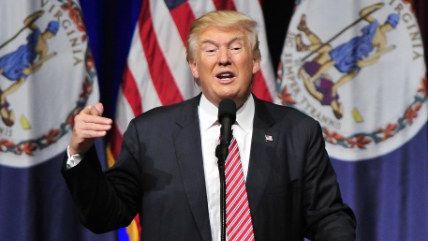Donald Trump Promises to Out-Pork All Comers With More Than $500 Billion in Infrastructure Spending
He won't have his massive spending plans outdone by Hillary Clinton.


The criticism at the Democratic National Convention last week directed toward Donald Trump had at least one significant flaw: They acted as though he had no policy plans at all, though in reality several of his economic proposals mimic what we hear from Democrats themselves. His anti-trade positions, his desire to punish companies that leave the United States, and his desire to use federal infrastructure spending as a jobs program all mimic things said by Democrats and even Hillary Clinton herself.
But Trump is a particularly special candidate in that he simply cannot allow anybody else to offer something that in his mind is better or bolder than what he's offering. So in an interview this morning, knowing that Clinton has proposed a $275 billion infrastructure spending plan over five years, Trump told Fox Business News that he would "at least" double that amount of spending.
So that would be at least $550 billion in spending. Remember that the big stimulus money spent under President Barack Obama's administration totaled $833 billion.
At the exact same time (in the same interview, no less), Trump says he's going to implement "the biggest tax decrease." This is crazy nonsense, and he says that he'll pay for his plan with a "fund" where people would "invest."
One big problem here (among many big problems) is that Trump, like Democrats, are focusing on infrastructure projects as a job program instead of a program narrowly focused on fixing the actual infrastructure—those bridges Trump says he is worried about. A focus on jobs indicates a desire to spread money around using infrastructure needs as a justification, not a purpose. As Peter Suderman noted in a Reason magazine cover story in 2013, the emphasis on using infrastructure spending as a "stimulus" rather than a plan to fix actual defined problems resulted in things like spending millions of dollars on toilets in national parks and ultimately a lack of evidence that it actually improved our economic situation.
Nobody wants to be an "investor" in such a program because everybody wants to be the beneficiary. This is a program where people want to receive the money, not pay into it. If Trump (or Clinton, for that matter) needs a better example, check out California's high-speed rail plans. This is a pure example of a program that has been designed to spread around money, not meet actual infrastructure needs of the Golden State. That it's passing through the central area of California instead of zipping between the urban centers of San Francisco and Los Angeles is a blatant payoff to make sure various labor groups get work and get their share of the pot (and for the local politicians to get credit and votes for bringing home some bacon). As such, particularly given the unlikelihood of the train ever operating at a break-even point, let alone a profit, they are unable to draw in private investors. People realize all the money is in building the train, not running it.
So is the potential for both Trump's and Clinton's infrastructure plans. If the goal is to spread around money, there will be plenty of hands out, but actual infrastructure needs become subservient to who has the most power and influence over the spending process. China, which Obama himself once praised for its infrastructure spending, has instead become a massive example of how government spending for the sake of creating the appearance of growth leads to cronyism, corruption, and eventually actual threats to public safety from shoddy outcomes. China spends big on infrastructure, and yet its bridges are still collapsing.
And let's not pretend that there hasn't been a constant drumbeat of jobs-focused infrastructure spending throughout Obama's administration, even beyond the initial stimulus. Matt Welch documented Obama frequently calling for more infrastructure spending as a jobs program, despite little evidence that this spending actual stimulated the economy.


Show Comments (75)